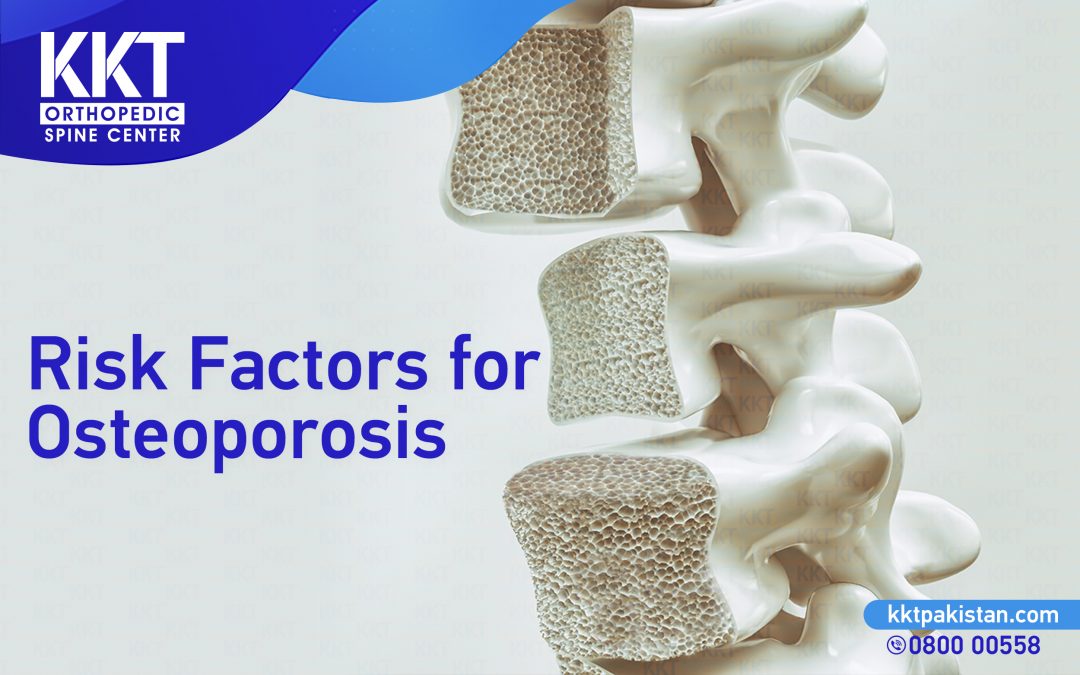Overview:
Osteoporosis is a bone-related disease that causes our bodies to lose bone material. As a result of weak and brittle bones the chances of fracture, increase. Term osteoporosis means porous or spongy bones. Therefore, osteoporotic bones have less mass and strength. Who is at risk of osteoporosis? There are various risk factors for osteoporosis. The risk of developing osteoporosis increases with age, gender, various lifestyle activities, and medical conditions.
Risk Factors for Osteoporosis:
There are several risk factors for osteoporosis. Among which some can be controlled others can’t. Following are some factors that increase the chance of developing osteoporosis:
- Age
- Gender
- Bodyweight
- Lifestyle Activities
- Certain medical conditions
Unchangeable Factors:
Age:
Our body is naturally producing new bone material. On the other hand, it’s also losing the older one. But as we get old, the process of making new bone material slows down. This results in lesser bone material hence weaker bones. Due to weak bones, the risk of osteoporosis increases.
Gender:
Osteoporosis can affect any gender. But the risk of developing osteoporosis is higher in women than men.
- Men and Osteoporosis:
Comparatively, men are less likely to develop osteoporosis. Women are 4 times more likely than men.
- Women and Osteoporosis:
In women risk increase after the age of 50 and post-menopause. This happens due to the change in hormones (estrogen). Estrogen plays a vital role in protecting bones. Due to a decrease in estrogen levels, osteoclasts increase and osteoblasts decrease. Osteoclasts are the cells responsible for bone absorption. Whereas osteoblasts are responsible for synthesizing new bone material.
Body Weight:
Women with thinner bone structure and body weight are more likely to develop osteoporosis. Therefore, maintain proper body weight.
Genetics:
Risk of osteoporosis increases due to family history. You’re more likely to develop osteoporosis if your parents have osteoporosis.
Manageable Factors:
Some of the modifiable factors include the following:
Lifestyle Activities:
Various lifestyle activities also increase the risk of osteoporosis. Including:
- Smoking:
Nicotine has various side effects on your body. Including, your risk for osteoporosis. So, quit smoking!
- Poor nutrition:
A balanced diet plays a vital role in bone health. So, intake adequate amounts of proteins, vitamins, and calcium especially.
- Eating Disorders:
Eating disorders can also increase the risk of osteoporosis. Restricting (anorexia) or excessive (bulimia) food intake can result in weakened bones. As inadequate food intake results in extreme weight loss. Therefore excessive food intake results in overweight.
- Less physical activities:
Loss of physical activities can also increase the risk of bone-related disorders and osteoporosis. Having a sedentary lifestyle comes with many cons. Exercises help improve your posture and strengthen your muscles as well as joints.
- Low calcium and vitamin D intake:
Calcium and vitamin D are essential for healthy bones and joints. Calcium intake is directly connected with osteoporosis. Vitamins also play a vital role in improving bone health and density. Hence, reducing the risk of fractures. Vitamin D helps to absorb phosphate and calcium in our bodies. Not consuming adequate vitamin D, can result in weak and brittle bones. Following are the sources for calcium and vitamin D:
- Vitamin D: Sunlight is one of the major sources including egg yolks, red meat, etc.
- Calcium: Yogurt, milk, butter, almonds, fishes like salmon and sardines, leafy vegetables, etc.
Medical Condition:
The risk of osteoporosis can increase due to several medical conditions and diseases. Some of them include:
- Celiac Disease
- Hyperthyroidism
- Rheumatoid arthritis
- Ankylosing Spondylitis
- Low estrogen or testosterone levels
Complications:
Other than fractures, there are various other complications of osteoporosis. For instance:
- Pain
- Height loss
- Hunch Back
- Limited mobility
- Anxiety and depression
Prevention:
Osteoporosis can also be prevented from a young age. Consequently, strong bones require a balanced diet, good nutrition, and regular exercise or other physical activities. Prevention of osteoporosis may include:
- Keep a healthy diet
- Absorb Vitamin D
- Quit or avoid smoking
- Consume calcium-rich foods
- Regularly exercise to keep your muscles and bones healthy.
KKT Treatment:
At present, there is no possible treatment for osteoporosis. However, since the past few years, there have been some elimination strategies and numerous treatment options. KKT Orthopedic Spine Center offers a highly sophisticated treatment option. A cutting-edge, non-surgical, and non-invasive treatment option for spinal restoration as well as conditioning in osteoporotic patients.
For further details visit our website here.
Alternatively, you can also contact us through our patient care line and one of our representatives will guide you to the best of their ability.
Phone: 0800-00-558
